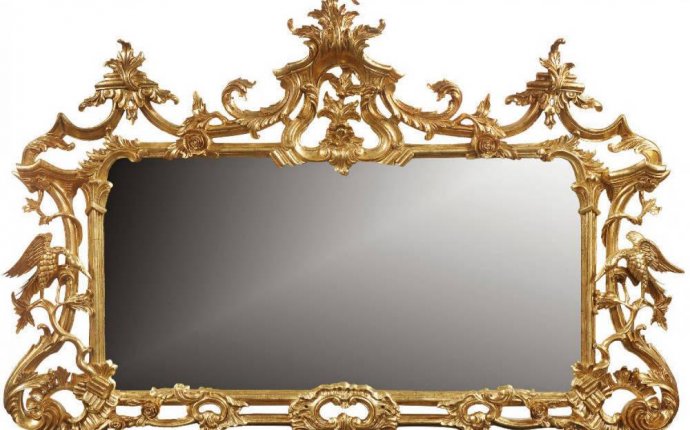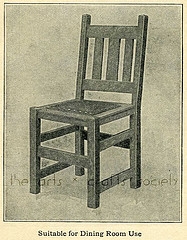
Period Furniture Image
 Scan, Mission Style Furniture, 1909
Scan, Mission Style Furniture, 1909
This article is a reprint of Chapter 8, p 100-105 of: Interior Decoration for the Small Home by Amy L. Rolfe, 1917. The images are from the book: Mission Furniture - How to Make It, 1909 from Popular Mechanics.
Origins of Mission Style
The mission furniture originated some thirty years ago in a little mission church in California. The church was a humble frame structure and the chairs made for it were of the simplest, straight line construction possible. Because they were so simple they seemed to possess an element of beauty, and the public soon recognized this fact and called for other straight line designs in inexpensive furniture.
Furniture makers all over the country abandoned, to some extent, the manufacture of much ornate, fantastically carved, light oak furniture, and bent their energies toward the making of straight-lined dark-stained mission furniture. Many of the designs were too heavy, were lacking in a fine sense of proportion, but much of the furniture was, and still is, good.
Mission furniture is often wrongly used, however. Many people forget, or are ignorant of, the fact that this style of furniture was originally designed for the bungalow type of building, where the woodwork of the rooms is on plain lines and is stained the same tone as the furniture. While mission furniture may seem very much at home in a western house, it may be entirely out of place in a house of the middle west, and surely would be incongruous in a colonial mansion of the east.
picture: Mission Furniture, 1909
Where mission furniture is well adapted to the home in which it is placed, great care should be taken in selecting the rest of the furnishings. Plain walls are best with mission furniture. If figured wall covering is especially desired, however, only that having a very conventional pattern should be selected. No attempt at daintiness should be made in a room with this type of furniture. The side hangings at the windows should be non-transparent, of firm weave, and, if figured, should be of geometric design. Some of the newer types of domestic rugs are more suitable for use with mission furniture than oriental rugs. Oriental rugs carry with them the spirit of the past and so are not appropriate for use with furniture of a distinctly modern type. The plain Wiltons with shaded borders are often used, but the texture of the many different makes of Scotch rugs seems most fitting.
from, Mission Style Furniture, 1909
Craftsman Style Furniture
Craftsman furniture is an outgrowth of mission furniture. The public soon tired of so much straight-lined, heavy furniture. People called for designs retaining all the good qualities of the mission furniture, but adding a feeling of grace and a certain degree of delicacy. This demand the manufacturers succeeded in meeting in many charming instances. The shops are now filled with modern furniture, much of which is really beautiful. Sometimes this furniture is of entirely new design. More often each piece is a successful composite of many antique motifs, so blended that an entirely new idea seems to have been originated. Some of this craftsman furniture is heavy and substantial looking, some is dainty and graceful. In all designs, however, there is a distinct lack of unnecessary ornament, and the charm depends entirely upon the extreme simplicity. Much of this furniture is very inexpensive and fills a national want for people of limited means.
This early simplicity movement called for harmony with nature, craftsmanship instead of shoddy machine-made material goods, dignity of the working man and woman. It was a backlash to the Industrial Revolution by philosophers and designers begun first in England, then migrating across the Atlantic to the US. The bungalow was the architectural manifestation of art pottery and mission-style furniture with which it is now so closely associated.
from: Mission Style Furniture, 1909
As with mission furniture, the most simple draperies, rugs, and wall coverings should also be used with craftsman furniture. With some of the more delicate designs, however, daintier backgrounds are permissible in the rooms where they are placed. The principles upon which both mission and craftsman furniture are based are honesty and simplicity. The wood is of the best quality and the workmanship must be exact, as any imperfections are at once noticeable in furniture of such simple lines. White oak is generally used, and in three different tones, as soft, light brown, a rich, nut brown, and a delicate silvery gray. Table tops are sometimes covered with hard leather, and soft leather cushions are often used in chairs and settles. As with period furniture, the mission and the craftsman types will never go out of style because they in themselves represent a new American period of design based upon natural lines which give comfort and durability, adapted to the lives of the great class of people. There is little chance for change in this style in the years to come, for it is impossible to get far away from the structural lines which give the purpose and use of each piece, and the proportions which best serve that purpose and use are the proportions which it should have.
There are several kinds of "straight line" furniture on the market which are also somewhat upon the mission order, and were probably first inspired by the early western designs. Furniture of this type comprises pieces which are well made, of good proportions, and equally possible for use in kitchen, office, or living room. The dignity of their simple lines makes them harmonious in any setting which is not elaborate.









